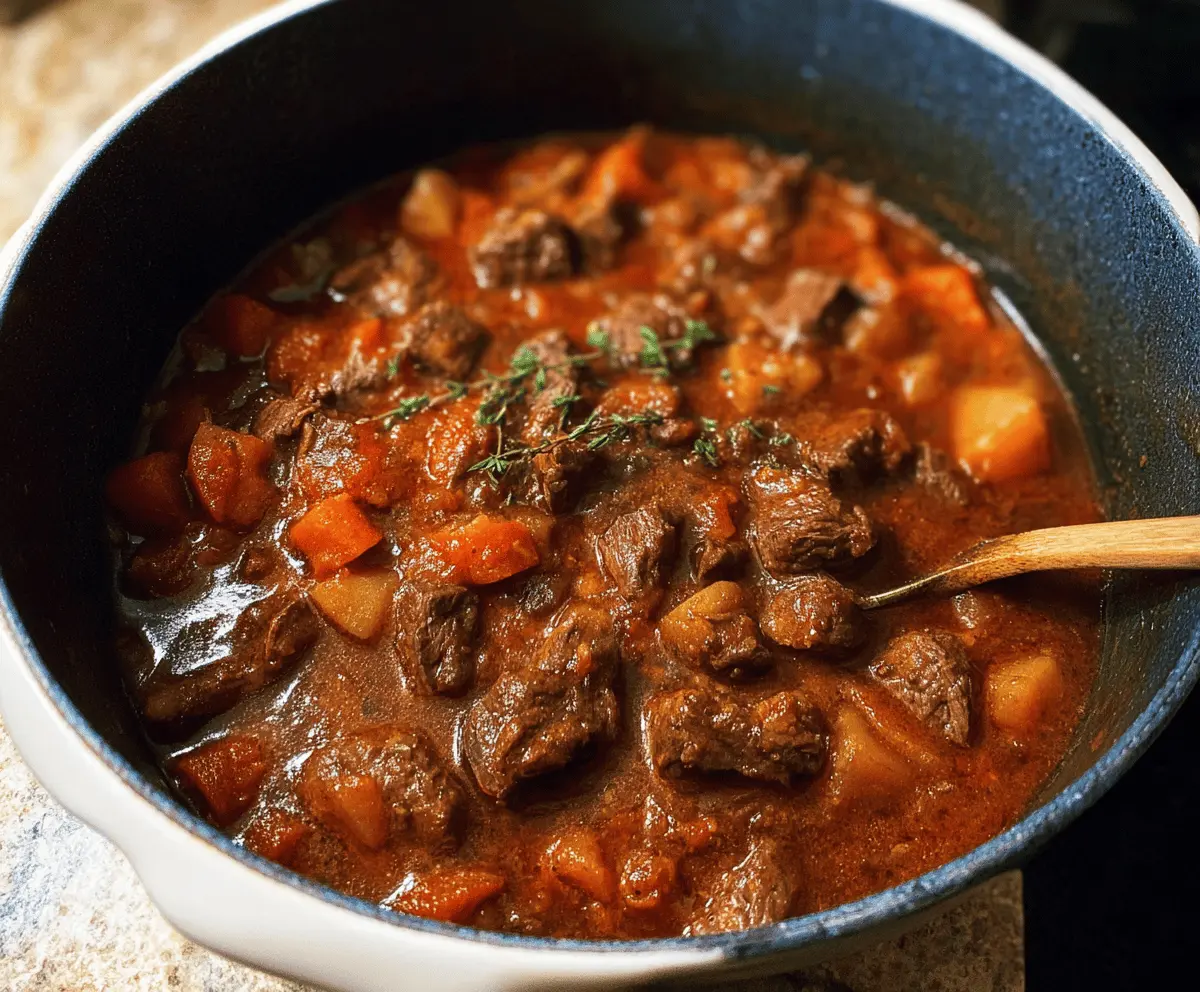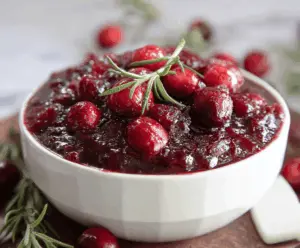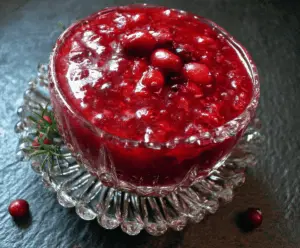This hearty stovetop beef stew is packed with tender beef, colorful veggies, and cozy flavors. It’s a warm hug in a bowl that’s perfect for chilly days!
I love how easy it is to make this stew. Just toss everything in one pot, let it simmer, and enjoy the aroma filling the kitchen. It’s like magic, and your taste buds will thank you!
Key Ingredients & Substitutions
Beef Stew Meat: Chuck roast is the best cut since it becomes tender as it cooks. However, you can substitute with brisket or round if you prefer. Just make sure it’s a cut that’s good for slow cooking!
Vegetables: Onion, carrots, and potatoes are classic, but you can easily swap in turnips, parsnips, or even bell peppers depending on what you have. Frozen veggies work too, just add them toward the end to avoid overcooking.
Broth: Beef broth gives great flavor, but you can use chicken broth for a lighter option. If you like a more intense flavor, homemade beef broth is awesome, or just dilute your broth with a little water.
Herbs: I used thyme and rosemary, but you can switch to Italian seasoning or just a bit of oregano if that’s what you have on hand. Fresh herbs are great if available, just double the amount!
How Do You Achieve Perfectly Tender Beef?
To get that mouthwatering tenderness in your beef stew, the secret lies in the cooking technique. Searing the meat first builds flavor and then simmering it low and slow is key. Here’s how:
- Brown the beef in batches so it sears nicely without steaming.
- After you add the broth and let it simmer, keep the temperature low. It should bubble gently, not boil aggressively. This makes the beef fork-tender.
- Let it cook for 1.5 to 2 hours. The longer you let it simmer, the better the flavors meld together.
Trust me, you will want to take your time with this step for the best results!
What’s the Best Way to Thicken a Stew?
If you want a thicker stew, using flour is one way, but you can also use cornstarch or even mashed potatoes as a thickening agent. Here’s a simple method:
- In a small bowl, mix 2 tablespoons of flour with 1/4 cup cold water to make a slurry.
- Stir this slurry into your stew during the last 10 minutes of cooking.
- Cook uncovered to allow it to thicken while stirring occasionally.
This quick trick helps avoid lumps and brings everything together nicely!

How to Make Stovetop Beef Stew
Ingredients You’ll Need:
Main Ingredients:
- 2 lbs beef stew meat, cut into 1-2 inch cubes
- Salt and black pepper, to taste
- 2-3 tablespoons vegetable oil or olive oil
- 1 large onion, chopped
- 3 cloves garlic, minced
- 3 medium carrots, peeled and sliced into chunks
- 2-3 medium potatoes, peeled and cut into chunks
- 2 celery stalks, chopped
- 3 tablespoons tomato paste
- 4 cups beef broth
- 1 cup water (optional, as needed)
- 1 teaspoon dried thyme
- 1 teaspoon dried rosemary
- 2 bay leaves
- 2 tablespoons all-purpose flour (optional, for thickening)
- Fresh parsley, chopped (for garnish)
How Much Time Will You Need?
This recipe takes about 15 minutes to prepare and around 1.5 to 2 hours to cook. So, set aside about 2 to 2.5 hours in total to enjoy this warm and hearty beef stew!
Step-by-Step Instructions:
1. Seasoning the Beef:
Start by seasoning the beef cubes generously with salt and black pepper. This helps to enhance the flavor right from the beginning!
2. Browning the Beef:
Heat 2-3 tablespoons of oil in a large heavy-bottomed pot or Dutch oven over medium-high heat. Add the beef in batches, making sure not to crowd the pot. Sear the beef until it’s browned on all sides. Once browned, remove the beef and set it aside. This step adds a lot of flavor to the stew.
3. Sautéing the Vegetables:
In the same pot, add the chopped onion. Cook it until it’s softened, about 3-4 minutes. Then, add the minced garlic and cook for another 30 seconds, just until it’s fragrant. This will create a lovely base for your stew.
4. Adding Tomato Paste and Veggies:
Next, stir in the tomato paste and cook for 1-2 minutes to enhance the flavor. Then, return the browned beef to the pot. Add the carrots, potatoes, and celery—all those delicious veggies!
5. Adding Liquid and Herbs:
Pour in the beef broth, and add water if necessary to just cover all the ingredients. Then, stir in the thyme, rosemary, and bay leaves. These herbs will give your stew that comforting aroma and taste.
6. Simmering the Stew:
Bring the stew to a gentle boil, then reduce the heat to low and cover the pot. Let it simmer gently for about 1.5 to 2 hours, or until the beef is tender and the vegetables are fully cooked.
7. Thickening (Optional):
If you’d like a thicker stew, you’ll want to make a slurry. Whisk 2 tablespoons of flour into 1/4 cup of cold water and stir it into the stew during the last 5-10 minutes of cooking. Cook uncovered to allow it to thicken.
8. Final Touches:
Before serving, taste and adjust the seasoning with more salt and pepper if needed. Also, don’t forget to remove the bay leaves from the pot!
9. Serving:
Garnish the stew with freshly chopped parsley for a pop of color and flavor. Serve hot alongside crusty bread or over buttered noodles for a comforting meal.
Enjoy your hearty stovetop beef stew—it’s sure to warm your heart and fill your belly!

Can I Use a Different Cut of Beef for This Stew?
Absolutely! While chuck roast is ideal for stew due to its marbling and tenderness, you can also use brisket or round. Just remember, tougher cuts will need longer cooking to become tender.
How Do I Store Leftover Beef Stew?
Store any leftovers in an airtight container in the refrigerator for up to 3-4 days. You can also freeze the stew for up to 3 months; just be sure to cool it completely before sealing it in a freezer-safe container.
Can I Add Other Vegetables to the Stew?
Yes, definitely! Feel free to add in your favorite vegetables like peas, green beans, or bell peppers. If you’re using frozen vegetables, add them in the last 20-30 minutes of cooking to keep them from getting mushy.
How Can I Make This Stew Gluten-Free?
To make this stew gluten-free, simply skip the flour for thickening. Instead, you can use cornstarch mixed with water or add pureed potatoes or other vegetables to achieve a thicker consistency.


